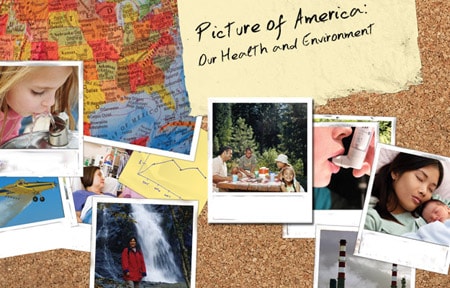Picture of America Executive Summary
The environment where we live, work, and play affects our health. People are exposed almost daily to health hazards from air, water, homes, food, and climate. Over the past several decades, our understanding of the connection between the environment and our health has grown tremendously. Picture of America: Our Health And Environment details major environmental health problems the country currently faces, providing a clearer understanding of the role of the environment in human health and the increasing need for better data to understand that role.
Members of the public can use Picture of America to make informed decisions to protect their health and the health of their families and communities. Picture of America can be a valuable resource for public health professionals and decision-makers. Knowing the leading environmental health issues enables leaders to prioritize resources and plan interventions and programs for maximum impact.

Picture of America Modules
Each topic area in the Health section provides information on an individual health outcome, including a discussion of the disease, factors that increase a person’s chance of getting the disease, and statistics on the impact of the illness on the population.
The Environment section reviews a broad scope of environmental issues that may affect human health. Each topic area briefly reviews any existing scientific evidence of the association between the environmental problem and adverse human health outcomes, displays relevant environmental monitoring data, and discusses ways for the reader to reduce individual risk.
Informing Decisions
The goals of Picture of America are to
• provide an overview of priority environmental hazards, exposures, health effects and interventions.
• describe the importance and highlight accomplishments of environmental public health practice and service.
• demonstrate the need for increased and better understanding of the relationship between environmental factors and human health as critical to short- and long-term planning locally and nationally.
• raise awareness of various environmental health issues with different stakeholder groups and decision-makers.
Key Messages
The relationship between exposures to environmental hazards and health concerns is complex. Genetics, behavior, socioeconomic, and other factors contribute to health and disease. These factors can modify and confound the link between an environmental exposure and a specific health problem. In some situations, the environmental link is proven and well-documented, but in other cases, environmental links to disease are just being suspected and investigated.
Exposure to hazards occur over our entire lifetime. Children are vulnerable to hazards in the home, such as secondhand smoke, lead, and pesticides. These exposures may lead to acute respiratory infections, learning disabilities, and nervous system damage among other health concerns. Young women in their reproductive years are vulnerable to hazards that can cause miscarriages, infertility and birth defects. Many adults are exposed intermittently throughout their careers to hazards in their work environment. And the elderly, while particularly vulnerable to the hazards of air and noise pollution and extreme heat, might see the results of a lifetime of exposures to hazards in the development of cancers, chronic kidney disease, heart disease and stroke.
There are steps we can take to prevent, correct, and even eliminate exposure to harmful environmental hazards. Most prevention begins with awareness of where hazards exist and how they can be avoided. In addition, prevention efforts can also occur at the larger community, state, and national levels. As with the impressive efforts made to reduce Americans’ exposure to secondhand smoke and the campaign to dramatically reduce lead exposures among young children, community and societal prevention efforts can also be successful with other hazards that are currently affecting us. Furthermore, through action, prevention, and planning, not only can we avoid and eliminate environmental hazards, we can also create an environment that has a positive influence on our health.
Expanding our Knowledge
While scientists, epidemiologists, public health officials, and medical experts constantly work to expand our knowledge about environmental connections to health and disease, there is still much we do not know. CDC has taken some major steps to begin to fill this gap through its National Environmental Public Health Tracking Network (Tracking Network).
The Tracking Network includes health and environmental exposure data from a variety of national, state, and city sources. The Tracking Network provides funds to 26 state and local health departments to develop local tracking networks. These networks also feed into a National Tracking Network, where this data can be used to create maps, tables, and charts on a wide range of health indicators. The Tracking Network gathers information that is needed to make informed decisions about our environment and our health. By utilizing the Tracking Network and continuing to expand sources of environmental and health data
• Scientists are better able to assess the connections between the environment and its effect on health.
• Public health professionals now can easily assess unusual trends and events to determine which communities may be at risk.
• Government officials can make more informed policy decisions, and people can learn more about how the environment may affect their health.